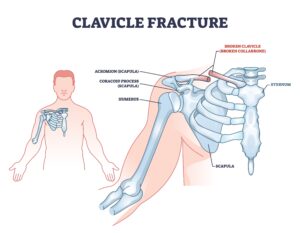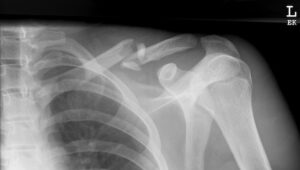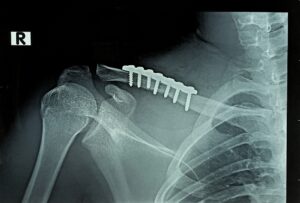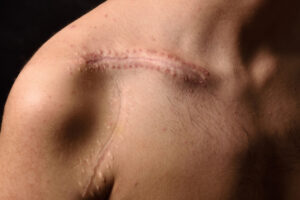Are you experiencing the persistent discomfort and limitations that come with a clavicle fracture? The pain can be excruciating, affecting your daily life, whether you’re an active athlete or simply going about your routine. At the Sydney Orthopaedic Surgeon Clinic, we understand the challenges that clavicle fractures pose, and we’re here to guide you back to your full potential.
Leading our team is the highly experienced Dr Stuart Kirkham, a distinguished orthopaedic surgeon renowned for his expertise in orthopaedic care. With over 25 years of experience, Dr Kirkham specialises in treating a wide range of upper limb conditions across his five clinics within the Sydney region, and clavicle fractures are one of several conditions he treats on a regular basis. His commitment to personalised patient care ensures that each individual receives tailored treatment options to address their unique needs.
Under Dr Kirkham’s guidance, our clinics offer a range of treatments for clavicle fractures. Whether your case requires non-surgical approaches such as pain management, the provision of a sling and follow-up care, or more intensive surgical interventions like open reduction and internal fixation, we’ve got you covered. Dr Kirkham and his dedicated team are here to provide the support and care you need to embark on your journey toward recovery.
If you find yourself concerned about a clavicle fracture, we urge you not to delay seeking assistance. Take the first step toward improved quality of life and a pain-free future by reaching out to us today to schedule a consultation with Dr Kirkham. Your path to recovery starts here.
Anatomy of the Shoulder Joint
The shoulder joint is a complex structure that enables us to perform tasks as simple as raising an arm and as intricate as throwing a ball. This structure is made up of three bones – the clavicle (commonly known as the collarbone), the scapula (or shoulder blade), and the humerus (the upper arm bone) – this joint is a critical component in facilitating the arm’s connection to the body.
Situated between the ribcage and the shoulder blade, the clavicle plays a pivotal role in maintaining the upper limb’s stability and functionality. Its graceful curvature acts as a bridge, connecting the arm to the body while allowing for a certain degree of movement. This structure also provides protection to the nerves and blood vessels that run beneath it. These include the brachial plexus, a network of nerves that control arm and hand movement, as well as the subclavian artery and vein, which are essential for blood circulation to and from the upper extremities.

One reassuring fact is that vital structures are rarely compromised during a clavicle fracture. The body’s design protects these critical elements, minimising the risk of severe complications. While clavicle fractures can be painful and inconvenient, the body’s resilience ensures that the most vital functions remain unaffected.
Understanding the intricacies of the shoulder joint and its surrounding structures is crucial in diagnosing and treating clavicle fractures effectively. Dr Kirkham’s expertise in orthopaedic care ensures that you’ll receive the most accurate assessment and personalised treatment plan for your clavicle injury. Get started on your journey to a more comfortable daily life – reach out to Dr Kirkham today and take the first step toward addressing your clavicle fracture.
Causes, Types and Risk Factors for Clavicle Fractures
Clavicle fractures are highly common and can affect individuals of all ages. While they account for approximately 5% of all adult fractures, teenagers and children are at the highest risk of these injuries, with the risk falling after the age of 20 but rising among the elderly. The location of these fractures typically occurs in different segments of the clavicle, with the middle third (the shaft) being the most commonly affected area. This portion is more susceptible to fractures due to its relatively thinner structure compared to the sturdier ends.
The clavicle can face many different types of fractures, ranging from slight cracks to more complex comminuted fractures. One specific condition to take note of is distal clavicle osteolysis, which is an injury where the end of the clavicle bone starts to deteriorate, often due to repetitive strain or trauma. Distal clavicle osteolysis tends to occur because the bone is not given the time it needs to heal, and its gradual deterioration can lead to chronic inflammation and the formation of scar tissue.

Clavicle fractures can further be categorised as displaced or non-displaced fractures. Displaced fractures involve a significant shift in the alignment of the bone fragments, while non-displaced fractures maintain the bone’s relative position. The differentiation between these types is crucial in determining the appropriate treatment approach.
Common causes of clavicle fractures include direct blows to the shoulder, falls, and accidents. Due to the clavicle’s critical location, any substantial force applied to the shoulder, such as falling directly onto it or onto an outstretched arm, can lead to a fracture. This makes the collarbone one of the most frequently broken bones in the body.
While these injuries are common, Dr Kirkham benefits from extensive experience in treating clavicle fractures, and can he provide specialised expertise to diagnose and address your individual injury. Don’t hesitate to reach out to Dr Kirkham at the Sydney Orthopaedic Surgeon Clinic for expert care and support in managing clavicle fractures.
Symptoms and Identification of Clavicle Fractures
Clavicle fractures can manifest in a range of symptoms that can be both uncomfortable and limiting. One of the most prominent and often distressing symptoms is simply the pain that a clavicle fracture creates. This is usually localised to the injured area, but it can radiate to the surrounding shoulder region. This pain can range from mild to severe, depending on the extent and type of fracture.
Mobility issues are also common with clavicle fractures. Individuals may find it challenging to perform even simple tasks, such as lifting the arm or reaching for objects. The fracture can significantly restrict the range of motion in the shoulder, making everyday activities cumbersome.
Another notable sign of a clavicle fracture is a sagging shoulder, where the affected shoulder appears lower than the unaffected one due to the displacement of the clavicle bone. Individuals with clavicle fractures often struggle to lift their arms, and attempting to do so can exacerbate the pain. A grinding sensation may also be felt when trying to move the arm, a result of the rough edges of the fractured bone rubbing against each other.

In some cases, a deformity may be visible or palpable at the site of the fracture, and bruising can also occur, especially if the injury resulted from trauma or an accident. This can be a result of blood vessels being affected by the fracture.
If you’ve been experiencing any of these symptoms, it is highly advisable to seek consultation with a specialist who possesses the necessary medical knowledge and expertise. Dr Kirkham is well-versed in addressing clavicle fractures and can provide individualised and highly effective treatment options that can deliver the best possible outcome for your case. Don’t hesitate to reach out to Dr Kirkham for a consultation at one of his five clinics today.
Diagnosis and Imaging of Clavicle Fractures
Diagnosing a clavicle fracture is a critical step in determining the appropriate treatment plan. To accurately assess and confirm the presence and severity of the fracture, Dr Kirkham undertakes a thorough examination process that begins with a physical examination. In this examination, Dr Kirkham inspects the affected area for tenderness, swelling, or any open wounds. This examination helps to gauge the extent of the injury and any associated soft tissue damage.
To gain a comprehensive understanding of the fracture, Dr Kirkham also uses a range of imaging techniques. X-rays are an invaluable tool in diagnosing clavicle fractures. They provide clear visual information about the location, type, and severity of the break, as well as whether any surrounding joints have been affected. A clavicle X-ray offers a quick and effective way to assess the injury.

In some cases, additional imaging may be required to obtain more detailed information. A computed tomography (CT) scan can provide highly detailed images, particularly if the fracture is complex or involves multiple fragments. This advanced imaging technique offers a deeper insight into the nature of the injury, aiding in precise diagnosis and treatment planning.
Furthermore, a bone scan may be considered if there are concerns about possible complications or underlying issues. While not always necessary, it can be a valuable diagnostic tool to evaluate overall bone health and identify any potential abnormalities.
If you suspect that you may be experiencing symptoms of a clavicle fracture or have encountered an incident that raises concerns, it is crucial to seek expert medical advice for a thorough diagnosis. Dr Kirkham and the dedicated team at the Sydney Orthopaedic Surgeon Clinic possess extensive experience in diagnosing and treating clavicle fractures. Beginning with a thorough diagnosis, their specialised care and guidance can set you on the path to recovery. Don’t hesitate to contact our friendly team to schedule a consultation with Dr Kirkham and receive the expert care you deserve.
Treatment Options for Clavicle Fractures
When it comes to treating clavicle fractures, Dr Kirkham and his team can take a few different approaches, each tailored to the specific circumstances of the injury. The choice of treatment depends on factors like the severity and location of the fracture, as well as the patient’s overall health and lifestyle.
In general, the treatment of a broken clavicle can be categorised into two main approaches: non-surgical and surgical. Non-surgical treatment is often considered for less severe fractures or fractures that are expected to heal properly with conservative methods. This approach typically involves immobilisation with a sling or brace to allow the bones to heal naturally over time. Pain management is also an integral part of non-surgical treatment, aiming to minimise discomfort during the healing process.
On the other hand, surgical treatment may be recommended for more complex clavicle fractures. One common surgical procedure is Open Reduction and Internal Fixation. During this surgery, the bone fragments are carefully repositioned into their normal alignment (reduced) and then secured in place using specialised metal hardware such as plates and screws. This hardware holds the bone fragments together, allowing for proper healing. In some cases, patients may notice a small patch of numb skin below the incision, but this numbness typically diminishes with time. While the hardware is not routinely removed after the bone has healed, it can be addressed if it causes discomfort or irritation.

In situations involving distal clavicle osteolysis, Dr Kirkham may use a surgical approach called distal clavicle excision. This procedure involves removing the degenerated end of the clavicle to create more space within the joint, enhance the range of motion, and alleviate pain.
Pain management is a fundamental aspect of clavicle fracture treatment, and it informs both surgical and non-surgical treatment approaches. These may include medications, physical therapy, and lifestyle adjustments to ensure the patient’s comfort throughout the healing process.
Dr Kirkham has the expertise to deliver an accurate diagnosis and undertake the most suitable treatment method with care and precision. With his dedication to personalised care and the backing of his experienced team, Dr Kirkham is well-equipped to fast-track your recovery and minimise your discomfort. Don’t hesitate to contact us to schedule a consultation and begin your journey toward healing.
Prevention and Aftercare for Clavicle Fractures
Preventing clavicle fractures can be challenging, as they often occur due to unforeseen circumstances or accidents. However, there are some proactive steps that individuals can take to reduce the risk of these injuries. Firstly, using proper technique and maintaining good body positioning while participating in sports or engaging in physical activities can help minimise the chances of a clavicle fracture. Additionally, wearing all necessary protective gear or appropriate safety equipment when playing high-contact sports or pursuing hobbies can provide essential protection.
Maintaining a well-balanced diet is also crucial for bone health. Ensuring an adequate intake of calcium can help strengthen bones, making them more resilient to fractures. Calcium-rich foods like dairy products, leafy greens, and fortified foods can contribute to bone health.
Furthermore, seeking appropriate medical care and adhering to follow-up care recommendations are vital aspects of preventing complications and ensuring a smooth recovery. Timely follow-up appointments with Dr Kirkham allow him to monitor the healing process and address any concerns promptly.
At the Sydney Orthopaedic Surgeon Clinic, Dr Kirkham and his team of experienced professionals are dedicated to providing comprehensive aftercare for clavicle fractures. Our primary aim is to support your recovery, enabling you to return to your regular daily activities with confidence. If you’ve experienced a clavicle fracture and haven’t yet received an effective aftercare plan, don’t hesitate to reach out to Dr Kirkham for specialised care tailored to your specific needs. Together, we can work towards restoring your shoulder health and overall well-being.
The Recovery Process for Clavicle Fractures
The recovery process for a clavicle fracture involves several stages, with the timeline varying depending on the chosen treatment approach and individual factors. Typically, whether treated conservatively or with surgery, it can take several months for the collarbone to fully heal. However, the healing process may be extended for individuals with certain health conditions like diabetes or those who smoke or use tobacco products.
For most patients, returning to their regular activities occurs within approximately three months of the injury. However, the key to a successful recovery is ensuring that the fracture is stable enough to handle the demands of daily life and physical activity. Returning to regular activities or lifting objects with the injured arm prematurely can disrupt the healing process, potentially causing the fracture fragments to shift or the hardware used in surgical treatment to break. Such setbacks may necessitate starting the treatment process anew.
The recovery process typically involves distinct stages. Initially, the focus is on pain management, protection of the injured area, and the prevention of complications. As healing progresses, physical therapy and exercises play a pivotal role in restoring strength, mobility, and function to the shoulder. It’s important to remember the recovery timelines for patients who underwent conservative treatment methods differ to those individuals who underwent surgical treatments.
Once the fracture has completely healed, patients can safely return to sports activities and their regular routines. The timeline for this transition will be guided by Dr Kirkham following an assessment of the patient’s progress to ensure that the shoulder is stable enough to resume full physical activity.
Dr Kirkham and the dedicated team at the Sydney Orthopaedic Surgeon Clinic are committed to supporting you through every stage of your clavicle fracture recovery. Dr Kirkham’s expertise and commitment to your health and comfort will help you achieve a successful and smooth recovery journey, ensuring that you can return to your everyday activities with confidence.
Possible Complications of Clavicle Fractures
While the majority of clavicle fractures heal without complications, there are potential issues that can arise during the recovery process. Two notable scenarios are non-union and malunion. In some cases, the fracture may move out of place before it fully heals. This can result in a condition known as non-union, where the fractured bone fails to mend. Non-union can manifest with varying degrees of pain and mobility limitations. In some instances, patients may require further surgical intervention to address the non-union and promote proper healing.
On the other hand, malunion occurs when the fractured bones heal in an incorrect position. The extent of surgical treatment for malunion depends on factors such as the degree of misalignment and its impact on arm movement. In some cases, a noticeable bump may develop at the site of the fracture during the healing process. While this bump often reduces in size over time, a smaller bump may persist permanently.

Surgical treatment for clavicle fractures carries its own set of considerations and potential risks. General surgical risks include infection, bleeding, problems with wound healing, pain, blood clots, damage to blood vessels or nerves, and reactions to anaesthesia. Specific to surgery for clavicle fractures, there is a risk of difficulties with bone healing, lung injury, numbness below the clavicle, hardware irritation, and cosmetic concerns like bumps over the healed site.
It’s important to recognise that complications are relatively rare, and the decision to undergo surgery is typically made after careful evaluation of the risks and benefits. Dr Kirkham has completed these surgical procedures numerous times and has all the necessary expertise to guide you through this process, ensuring that you receive the most appropriate treatment and attentive care tailored to your specific needs.
If you have concerns about clavicle fractures or have experienced complications during your recovery, don’t hesitate to consult with Dr Kirkham for expert guidance and personalised care. Your well-being is his priority, and Dr Kirkham is always ready to address your concerns and support you on your journey towards recovery.
Are You Concerned About Clavicle Fractures?
If you’re concerned about a clavicle fracture or experiencing symptoms such as pain, limited mobility, or discomfort in your shoulder area, it’s crucial to seek medical attention promptly. Clavicle fractures can significantly impact your daily life and addressing them correctly is essential to ensure a smooth recovery.
Dr Kirkham and the experienced team at the Sydney Orthopaedic Surgeon Clinic are dedicated to providing effective and individualised care for clavicle fractures. Whether you have a minor fracture or are dealing with more severe complications, we are here to support your journey to recovery.
Don’t let a clavicle fracture disrupt your life. If you’re concerned about this injury, reach out to us today to schedule a consultation with Dr Kirkham. By taking this proactive step, you can initiate the process of improved mobility, reduced pain, and an enhanced quality of life. Our team will conduct a thorough assessment and create a personalised treatment plan tailored to your specific needs.
FAQs
1. How long does a clavicle fracture take to heal?
A clavicle fracture typically takes around 6 to 12 weeks to heal. During this time, it’s common to experience some aches and discomfort. Additionally, the affected area may remain sensitive for several months after the healing process is complete. Dr Kirkham and his team at the Sydney Orthopaedic Surgeon Clinic can provide expert guidance and monitoring throughout your recovery journey, ensuring that your healing progresses as smoothly as possible.
2. Do all clavicle fractures need surgery?
While many clavicle fractures can be managed with a sling to immobilise the arm and shoulder, some more complex fractures may require surgery. Surgical intervention is typically recommended when the bone fragments have moved significantly out of place and need realignment. Dr Kirkham, an experienced orthopaedic surgeon, can evaluate your specific fracture and recommend the most appropriate treatment approach tailored to your condition and needs.
3. What is the most frequent complication of clavicle fracture?
The most common complication of clavicle fractures is malunion, where the fracture heals with an abnormal angulation, shortening, or poor cosmetic appearance. Dr Kirkham and his team are well-versed in managing complications like malunion, ensuring that patients receive the necessary care and intervention to address these issues and optimise their recovery.
4. What movements should you avoid with a clavicle fracture?
To support the healing process, it’s important to maintain shoulder mobility while avoiding movements that may exacerbate the injury. For the first six weeks, it is advisable to refrain from lifting heavy objects and performing overhead movements. Adhering to these guidelines helps promote proper healing. After this initial period, you’ll have a follow-up appointment with a shoulder specialist, such as Dr Kirkham, who will evaluate your progress and provide further guidance on gradually resuming normal activities.
5. What is the role of physical therapy in clavicle fracture recovery?
Physical therapy plays a crucial role in clavicle fracture recovery. It helps restore shoulder strength, flexibility, and range of motion. Under the guidance of Dr Kirkham and his team, a customised physical therapy program can be developed to aid your specific needs. This ensures that you regain optimal function in your shoulder and return to your regular activities with confidence.
References
- OrthoInfo (Clavicle Fracture (Broken Collarbone))
- Mayo Clinic (Broken Collarbone)
- John Hopkins Medicine (Clavicle Fractures)
- Nationwide Children’s Hospital (Clavicle Fracture)


